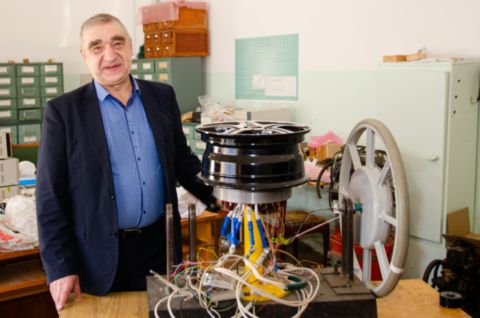Students and young scientists from the SUSU Institute of Engineering and Technology are conducting research on creating electric transmissions for ground transport based on a motor-wheel. This technology with powerful magnets and a special winding design makes it possible to make the wheel 25% smaller in size and 20% more energy efficient than existing analogues.
It has many advantages, such as freeing up the engine compartment of an automobile and increasing driver comfort. And most importantly, achieving high speeds. The group of young scientists is headed by Professor of the Department of Electric Drive, Mechatronics and Electromechanics of the Institute of Engineering and Technology, Doctor of Sciences (Engineering) Sergey Gandzha. His student Ivan Chuyduk became a Candidate of Sciences (Engineering) in December 2023, having defended his thesis on the topic of Synthesis and Analysis of Combined Excitation Switched-type Electric Motors for Electric Transmissions of Land Vehicles.
.jpg)
A motor-wheel is a complex unit that combines the wheel itself, an electric motor, a cooling system, a gearbox and a braking system. Using such wheels eliminates the need for complex transmission mechanisms, provides high efficiency, improved dynamics, and easy implementation of active safety algorithms.
The combination of these factors provides up to 20% battery saving.
It is also important to develop a software package that controls movement. The structure of the motor-wheel allows to change the torque and frequency of its rotation during movement.
“An electric racing car needs high torques at the start and high speeds while driving,” says Ivan Chuyduk. “We have developed and studied a combined excitation switched-type electric motor of an innovative design. Due to the unique design of our motor-wheel, we were able to provide a wide range of its regulation, and at the same time, reduce the weight and volume of the engine. Experiments at the stand confirm the result.”
.jpg)
“All the existing analogues are either too large in size and weight, or have a limited range of regulation,” says Professor Sergey Gandzha. “We managed to expand the rotation speed range with smaller dimensions. The specifics of such motors lies in the structure of the inductor, which combines powerful permanent magnets and an excitation winding. The magnets reduce the volume and weight of the motor, and the winding expands the range of control of motion parameters. The design made it possible to reduce overall losses and increase efficiency by 5-7% compared to foreign analogues. We received patent No. 2807034 of the Russian Federation for our technical solutions.”
In the future, the motor-wheel of a similar design can be used in both passenger cars and trucks.
“As for commercial electric vehicles with a carrying capacity of up to 10 tons, the use of such wheels in the design will allow achieving a significant saving effect by freeing up the engine compartment and placing the traction electric drive within the volume of the wheel disk. This, on one hand, increases comfort for the driver due to the location of service systems and, on the other hand, helps to place a larger volume of electrical energy storage and thereby increases the mileage without recharging. Based on the combination of all factors, automobiles with such wheels consume their battery power up to 20% more efficiently and increase the driving distance from a single charge by 30%,” summed up Sergey Gandzha.
The project by Professor Sergey Gandzha and his colleagues was supported by the Innovation Promotion Fund as part of the Umnik program (agreement No. 16559ГУ/2021 as of June 01, 2021) under the Student Startup program (agreement No. 1738ГССС15-L/88070 as of September 15, 2023).




